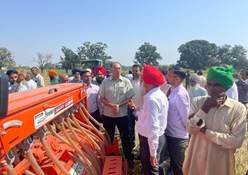Dhruv Sawhney, COO and Business Head, nurture.farm speaks to AgroSpectrum about the impact of the latest amendment in The Energy Conservation Bill, in August 2022, which empowers the central government to specify a carbon credit trading scheme and future of the carbon farming industry in India. Edited excerpts;
nurture.farm, a digital platform for sustainable agriculture, is the first company in India to successfully generate and forward-sell agricultural-related carbon credits. Established in December 2019, nurture.farm brings together the best agriculture solutions, including remote sensing, farm mechanisms, online marketplaces, traceability, and market linkage. The company’s Alternate Wetting and Drying & Dry Seeded Rice (AWD-DSR) project covered 22,000 acres of rice paddy fields and involved over 2,500 smallholder farmers. Around 20,000 carbon credits were derived from this project. Its benefits included 15 – 30 per cent in water savings. During the last cropping season (Rabi), nurture.farm expanded the AWD-DSR programme across an additional 120,000 acres.
The company plans to create more carbon credits by further extending its projects. In 2022, nurture.farm’s Crop Residue Management (CRM) Programme will cover at least one million acres, while it will scale up its AWD-DSR project to 180,000 acres. nurture.farm has set a target to help Indian farmers generate one million carbon credits by 2023, thereby being the leading supplier of nature-based carbon credits in India. Dhruv Sawhney, COO and Business Head, nurture.farm speaks to AgroSpectrum about the impact of the latest amendment in The Energy Conservation Bill, in August 2022, which empowers the central government to specify a carbon credit trading scheme and future of the carbon farming industry in India. Edited excerpts;
How is nurture.farm contributing to the growth of the carbon farming industry in India?
Agriculture and forestry are the only two industries that offer viable opportunities to remove carbon from the atmosphere and provide long-term storage in the soil to help sequester it. These two industries contribute significantly to carbon emissions and will assist us in meeting our aspirations of restricting global temperatures to 1.5 degree C above the pre-industrial level.
India is the second largest food producer in the world. Our company is working with Indian farmers and helping them switch to sustainable practices, where they can produce more nutritious food while sequestering more organic carbon in the soil using less water, less energy, and fewer chemicals while producing less GHG emissions. These shifts to sustainable practices are critical in improving farmer resilience against the impacts of climate change.
Rice/Paddy cultivation accounts for 2 Gigatons of GHG emissions annually, and India is the second largest rice producer worldwide. nurture.farm is working with paddy farmers to reduce their methane emissions by 50 per cent, water requirements by 15 to 30 per cent and improve their yields by 5 per cent.
nurture.farm forward sold the first set of agricultural carbon credits in India and compensated the farmers for this shift in practice. Additional income assistance and rewards go a long way in getting farmers to shift toward sustainable farming practices. This success story marks the dawn of sustainable agriculture in India which will bring in substantial revenues to the farmers and help mitigate global temperatures.
The latest amendment to The Energy Conservation Bill, in August 2022, empowers the central government to specify a carbon credit trading scheme. What will be the impact of this amendment on the carbon farming industry in India?
We await more clarity and details on the carbon credit trading scheme. Our hope is that India will learn from the mistakes and shortcomings of other carbon markets such as Europe and China and deliver one of the most robust, transparent and trustworthy platforms on the lines of UPI and AADHAAR, and lead the carbon trading scheme globally. We have the opportunity to become the benchmark for the world and ensure we reward people who are reducing carbon emissions handsomely.
What are the challenges in the carbon farming industry in India? Secondly, what inputs are required to grow the carbon farming industry in India?
The Perform Achieve and Trade (PAT) scheme rolled out by the government in 2008 has not been able to accelerate investments to reduce energy consumption in energy-intensive industries due to the low carbon pricing. Hence India should focus on ensuring that the floor price is attractive and in line with the international trading prices.
Secondly, the lack of trust in “quality” credits from Indian projects in the past, led to the collapse of the carbon markets. We hope that stringent monitoring and recording protocols are implemented to build trust amongst global buyers. There should be a stiff penalty for any carbon developer who does not deliver “Quality” Credits.
How do you foresee the future of the carbon farming industry in India and across the world?
The Taskforce on Scaling Voluntary Carbon Markets (TSVCM), sponsored by the Institute of International Finance (IIF) with knowledge support from McKinsey, estimates that demand for carbon credits could increase by 15x or more by 2030 and up to 100x by 2050. Overall, the global market for carbon credits could be worth upward of $50 billion in 2030.
China grew at a tremendous pace between 1995 and 2015, but it did not pay attention to energy efficiency, and as a result had to build thousands of coal plants to support this inefficient infrastructure. We should learn from this and ensure that we shape this new growth with the most efficient and low-carbon or zero-carbon systems. Carbon credit revenue is essential to finance these cutting-edge technologies.
Indian carbon project developers will play a vital role as a supplier of carbon credits to global corporations taking pledges to become carbon neutral. This will be a new and flourishing industry for the next 30 to 40 years.
What are the growth strategies and plans of the company for FY 22-23?
nurture.farm will generate more than a million carbon credits in FY 22-23 and help hundreds of thousands of Indian farmers to switch to at least one sustainable agricultural practice. nurture.farm also plans to expand its geographic footprint to Latin America in FY 22-23.
By Dipti Barve
dipti.barve@mmactiv.com
Dhruv Sawhney, COO and Business Head,










